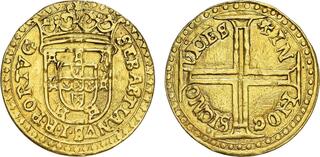| Numisma SA > Auction 139 | Auction date: 14 December 2023 |
| Lot number: 27 Price realized: Unsold | Show similar lots on CoinArchives Find similar lots in upcoming auctions on |
| Lot description: Portugal - Sebastião I (1557-1578) Gold - Engenhoso, undated; SEBASTIANVS.I.R.PORTVG / +IN-HOC-SIGNO-VICES; G.64.04, JS Se.11; 3.78 g; VF With a value of 500 Reais, the Engenhoso of D. Sebastião belongs to the select group of Portuguese coins of exceptional rarity and value. It is a "sought-after" piece in any public or private collection, even though it is difficult to acquire, given the scarce number of specimens that have come down to our days. However, above all, this coin bears witness to the first and unique technological innovation in monetary production in Portugal, which took place in 1562, with the use of a press invented by João Gonçalves, na artist from Guimarães, which made it possible to manufacture cast gold coins, in series, with a uniform quality, regular weight and na edge that could not be clipped, "without it being seen, and perceived" (Manoel Barbosa, 1732), this last a fraudulent practice which at that time was of great concern to those responsible for the Mint, as can be seen in the monetary law of 2 January 1560. The historical importance of this technological "leap", symbolised by the Engenhoso, cannot be overstated. It began to be developed during the reign of King João III, when João Gonçalves received sixty thousand reais from the king to build a device to manufacture coins, a fact attested to in a permit of 30 October 1553. Henri II of France was equally concerned with innovating the technology involved in coin production. In a document dated 3 March 1553, i.e. about eight months before the permit of Dom João III, he granted the position of "master and director of the machines for the production of cast coins" to Aubray Olivier, who would become the inventor of this process. Even if we do not know if this "invention" took place autonomously in France and Portugal, it is certain that the use of these presses was quickly abandoned in both countries, since the costs of such coin minting were much higher than hammered coinage. Manufacture of the Engenhoso is said to have taken place between 1562 and 1566, with no copies from 1564 being known, but those issued undated, to which the one shown here belongs, may be attributed to 1564 or to a date after 1566. The typology and legends of the Engenhoso follow that of the Cruzados introduced by the monetary law of 1560, with the Shield of the Kingdom, accompanied by the letters SEBASTIANVS.I.R.PORTVG, on the obverse, and the Cross of Christ, surrounded by +IN-HOC-SIGNO-VICES, on the reverse. Regardless of the different craftsmanship, the main difference between the hammered cruzados and those produced by João Gonçalves' press, lies in the well delineated border (with 3 distinct types, Gomes, 2013, p. 224), in order to make it more difficult to clip and, in the legend on the reverse, the intentional substitution of VINCES by VICES, where, as a rule, the I is accented with a tilde, providing a reading identical to that of the full word. This situation does not arise with undated examples, as is the case with the coin under consideration here. In short, the result is that the Engenhoso of D. Sebastião is nowadays a coin of exceptional rarity, of a technological innovation that tried to supplant, without success, the hammered coin technique, then more than two thousand years old, which, in Portugal, after the short-experiment undertaken with Antonio Routier's device in 1649, was only abandoned definitively in 1677. Starting price: 15000 EUR |  |


